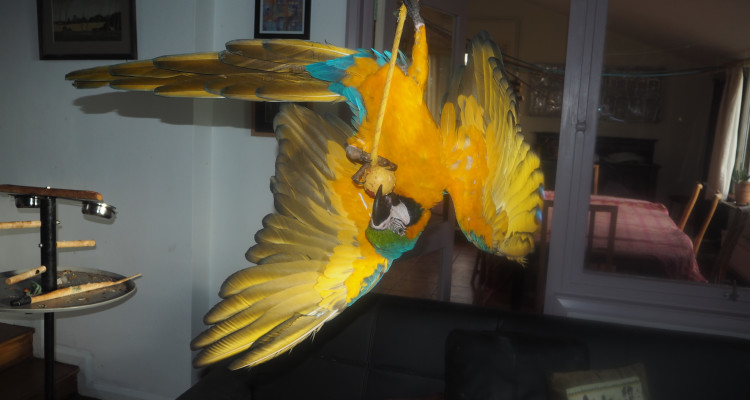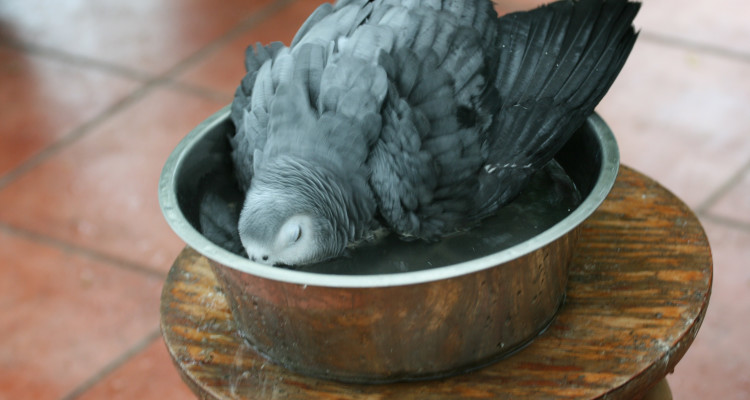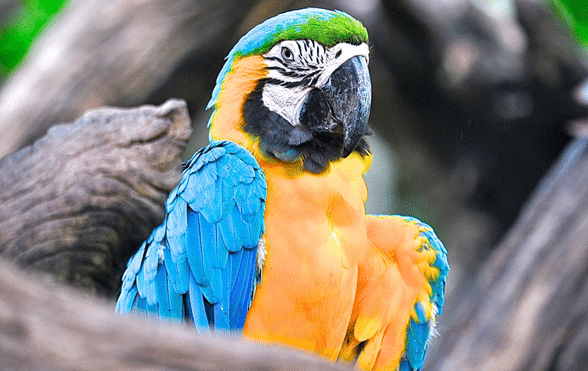Good training can and does reverse behavior that we don’t want in our companion birds. A young bird that has been well handled as a chick is eager to learn. But even a second hand bird that has developed habits you don’t want like biting, screaming, plucking, refusing step up, can be redirected into pleasanter one
Is your parrot insured? Get a quote for up to £5,000 of vet fee cover, death and theft cover | We’ve been insuring exotic pets since 1996 | Check out our customer reviews on Feefo.
Table of contents
What is positive reinforcement training in birds? | What is negative reinforcement used in bird training? | Punishment in training a bird | Benefits of positive reinforcement in bird training | How to train using positive reinforcement | Shaping a behavior with approximations | What is the capturing training method?
How to train your parrot
The best way to train a parrot is to use positive reinforcement.
You may like to read: How and why do parrots talk and teaching your parrot to talk
1. What is positive reinforcement training in birds?
Positive reinforcement means offering a reward, something the animal wants, likes or enjoys. Because the animal wants that reward again, she will repeat the behavior that seems to cause that consequence. It is possibly the easiest, most effective method for a trainer to control.
a. What is a primary reinforcer in bird training?
A primary reinforcer is usually a food reward. You don’t need to teach a bird what the reward is. (Needing food is an instinct that does not have to be learned)
b. What is a secondary reinforcer in bird training?
A secondary reinforcer is something the bird learns to value. It might be access to a toy or head rub.
For Benni my Macaw it is a Babble ball. If he flies back to the sitting room perch immediately, his Babble ball is immediately hung on the perch. He waggles its chain and bird noises emerge.
You may like to read: How to train a parrot to step up
c. What is a ‘cue’ in bird training?
A signal to the parrot what to do. Many trainers use verbal and/or hand cues.
Steve Martin can use a wink. To make Archie my Orange Winged Amazon dance, I have to sway from side to side, a movement too small to be noticed by people, but not Archie.
d. What is the ‘bridge’ used in bird training?
This is a signal to tell the bird ‘that was correct.’ The signal bridges the gap in time between the moment the bird performed the behaviour and the actual moment she gets her reward. Many use clickers, such as those sold by Northern Parrots, as a bridge.
You may also use a target stick (this is a slim baton) or a chopstick. (Barbara Heidenreich markets a target stick attached to a clicker).
You may like this also written by Dot: Caring for a parrot – an owners guide
2. What is negative reinforcement used in bird training?
In other words, something unpleasant is applied to the bird when he doesn’t perform the desired action. When he does perform the desired action, the unpleasant stimuli is removed.
To avoid negative reinforcers, learners only work to the level necessary to avoid them.
3. Punishment in training a bird
a. Positive Punishment
- escape behavior
- aggression
- apathy
- generalized fear
- learned helplessness
- loss of trust
|
Sixteen years ago, Perdy Lesser Sulphur Cockatoo knew step up and step into the crate. I knew the theory of behavior science but had not had much practice.
Perdy spent warm days in the aviary. One evening she wouldn’t fly down so I chased her, thinking crossly how naughty she was being.
From her point of view – why leave the sunny aviary for an indoors cage? I compounded the error a few days later by chasing her indoors to catch her. I caught her.
The result. The young bird lost trust in and would fly away from my hand. The problem was resolved with help of experienced friends but it took five months of daily work to regain her trust.
|
| Millie the cockatoo’s owners covered her cage to stop her screaming. The bird continued screaming in the dark – Sometimes covered all day and night. She soon began feather plucking. Months later, now she has a kinder home with a more sympathetic environment, her screaming has stopped but not the plucking. |
|
A professional trainer was forcing aggressive or fearful parrots to step up onto a perch using batons on either side of their bodies. The unfortunate parrots were harassed into submission. But loud complaints came from the owners that once back home, they would not repeat the behavior.
Animals trained in aversives will work the level necessary to avoid negative stimulus whereas animals trained in positive reinforcement will look forward to training and be more creative and attentive.
|

4. Benefits of positive reinforcement in bird training
- Step up onto the hand
- Recall to me from anywhere in house or aviary (usually not 100%)
- Go back into the cage
- Step up onto the hand of other people
- Enter a travel cage
- Allow themselves to be wrapped in a towel
- Step onto a scale
- Interact without aggressive behavior with other birds
- Stay on a designated perch (this behavior is one I have never managed to achieve as a confirmed one but I am still trying.)
- Retrieve an object (the dollar bill trick in bird shows)
- Talk on cue (none of my birds will do this except on occasion; I remain hopeful)
- Nail trims
- Beak trims
- Putting head in mask for anesthesia
- Blood draws
- Taking cloacal samples
- Using a nebulizer
- Taking drugs from a syringe
5. How to train using positive reinforcement
- Provide a suitable environment and eliminate distractions
- With a fearful or biting bird you may start training from inside the cage. Other birds train better in a different room from where their cage is.
- Eliminate distractions. It took me ages to realise that some birds need to be alone with the trainer; others don’t care a toss. Yet others will come and interfere.
- Keep a log book or a record book. I believe a log book or training record book, whatever you call it, is essential. Or like me you might forget what happened two days earlier.
You note first what behavior you are trying to train. Date, time, length of session. Any special things you observed. Sessions need not be long – 5-20 minutes is fine once or twice a day.
- Food management and weight management. Falconers and some professionals lower a bird’s weight to ensure it cooperates. This is not a technique for hobbyists. It needs a lot of experience to be used correctly.
Food management is not dangerous for a bird’s health or mental state. To manage food in a training situation, you will know how much food the bird eats in day.
You take out the favourite items and use them for rewards. You can also have special items the parrot only gets through training.
Amongst friends of mine, Bart used a pot of fruit yoghurt to recall his free flying Grey. I am training Mina the Military Macaw with half a pine nut for each flighted recall.
And if you want to train seriously take out the food bowls from the cage and train before breakfast and supper. The bird won’t starve if she hasn’t constant access to food. I weigh my birds weekly.
| Benni Blue and Gold Macaw prefers nut slivers. His treat for entering his cage is a walnut in shell. Mina, the Military Macaw likes pine nuts. My Greys like foods on the forbidden list like pizza, crackers and cookies. Most birds that I know will pay a lot of attention to a trainer when they twig that she is offering pomegranate seeds. Plan the session before a normal meal time and use as reward the bird’s favourite food item. |
- Your state of mind is important. Birds are super sensitive to their humans’ emotions. If you are feeling cross or unhappy or out of sorts, don’t train at that time.
An ideal state of mind to be in is to be focused completely on your bird and what he is trying to tell you with his body language.
|
I won’t name and shame them but when X and Y hit a bad patch and there was a lot of negative feeling around, the Grey parrot started to bite which he had never done before
|
Is your parrot insured? Get a quote for up to £5,000 of vet fee cover, death and theft cover | We’ve been insuring exotic pets since 1996 | Check out our customer reviews on Feefo.
Alternatively you can call us on 0345 982 5505
6. Shaping a behaviour with approximations
|
Using the terms described above and positive reinforcement as a training strategy, let’s follow the process of training a behavior. The first step is to identify a behaviour to train. Artha Grey did not like to bath herself. I would show her the bath and twirl a finger to get her to approach. NO way.
First step was to sit on the floor and close my left hand on sunflower seeds. Artha saw them alright. As soon as she walked towards my hand I said ‘Good’ and gave her a seed. She took it gently as she always does and scuttled away. By the end of the 15-minute session she was eating seeds on my hand held over the water.
A few sessions later I kept seeds in right hand and Artha on the left hand and lowered it into the water. Truthfully, I cannot claim to have fully taught the behavior because she realized that she actually quite liked splashing and will now do it of her own accord. Although, I no longer cue Artha to take a bath, nevertheless if she is in the water I will say ‘Good’ and give her a seed from my pocket.
|
 7. What is the capturing training method?
7. What is the capturing training method?
|
Here are some examples from my own flock. Bobo the umbrella cockatoo was a heavily plucked rescue and had the distressing habit of constantly raising her crest and bobbing up and down. It was a nervous habit, not a joyful one. However, within a few weeks as she settled down and many feathers grew, the nervous bobbing lessened. Each time she began it we praised her and sang “Happy Birthday”. Within a few weeks she had ceased the nervous unfurling of her crest, but was delighted to perform a little dance to “Happy Birthday”.
Benni macaw likes to hang on one leg from a rope. As he realized how appreciative we all were he began to perform the action for the verbal cue ‘one leg, Benni.’ I added ‘Wings, wings’ and he will spread both – now impressive to show off to visitors.
|
And finally
Is your parrot insured? Get a quote for up to £5,000 of vet fee cover, death and theft cover | We’ve been insuring exotic pets since 1996 | Check out our customer reviews on Feefo.


